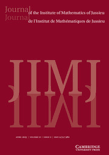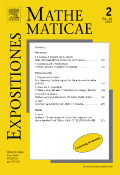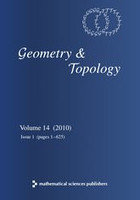
Kyoto Journal of Mathematics
Scope & Guideline
Fostering innovation in mathematics for a brighter future.
Introduction
Aims and Scopes
- Algebraic Geometry:
The journal publishes works related to the geometry of algebraic structures, focusing on topics such as moduli spaces, stable sheaves, and Gromov-Witten invariants. - Functional Analysis:
Research on function spaces, operators, and their applications is a significant area, including studies on Hardy spaces, BMO spaces, and various integral operators. - Topology and Homotopy Theory:
Papers exploring the properties of topological spaces, homotopy fixed points, and related concepts contribute to a deeper understanding of algebraic topology. - Representation Theory:
The journal includes research on the representation theory of groups, Lie algebras, and quantum groups, exploring their algebraic and geometric aspects. - Differential Geometry:
Studies on the geometric properties of manifolds, including symplectic geometry, curvature, and complex structures, are a notable focus area. - Category Theory and Homological Algebra:
There is a significant interest in categorical approaches to various mathematical problems, including derived categories and homological conjectures. - Stochastic Processes and PDEs:
Research involving stochastic partial differential equations and their applications in mathematical physics and probability theory is increasingly represented.
Trending and Emerging
- Noncommutative Geometry:
There is an increasing focus on noncommutative structures and their applications in various mathematical fields, including algebraic and differential geometry. - Mathematical Physics:
Papers that bridge mathematics and physics, particularly in the context of stochastic processes and PDEs, are becoming more prevalent, indicating a trend towards interdisciplinary research. - Symplectic Geometry and Topology:
The exploration of symplectic structures and their applications in various mathematical contexts, including mirror symmetry and deformation theory, is gaining traction. - Higher Category Theory:
Research on higher categorical structures and their implications for homotopy theory and algebraic geometry is emerging as a significant area of interest. - Quantum Algebra:
The study of quantum groups and their algebraic properties, particularly in relation to representation theory, is increasingly featured, reflecting a modern approach to algebra.
Declining or Waning
- Classical Number Theory:
While the journal has historically included number theory papers, the frequency of such publications has decreased, possibly reflecting a broader trend towards more geometric and algebraic approaches. - Elementary Geometry:
Papers on classical geometric constructions and properties have become less common, as the emphasis shifts towards more abstract and higher-dimensional geometrical contexts. - Real Analysis:
Topics primarily focused on real analysis, particularly those with less connection to modern applications or abstractions, appear to be diminishing in favor of more complex analytical frameworks. - Discrete Mathematics:
Research in discrete mathematics, including combinatorics and graph theory, has seen a reduction, suggesting a preference for continuous mathematical structures and theories.
Similar Journals

Documenta Mathematica
Advancing Mathematical Knowledge for AllDocumenta Mathematica is a premier academic journal published by the European Mathematical Society (EMS), making significant contributions to the field of mathematics since its inception. With an Open Access model established in 1996, the journal ensures that scholarly works are freely available to a global audience, promoting widespread dissemination of mathematical research. Based in Germany, it serves as a vital platform for mathematicians, covering a wide array of topics within the discipline, evidenced by its impressive Q1 ranking in the miscellaneous category of mathematics as of 2023. Featuring rigorous peer-reviewed articles that span the latest trends and breakthroughs in the discipline, Documenta Mathematica also retains a commendable position among its peers with a Scopus rank of 163 out of 399, placing it in the 59th percentile for general mathematics. Researchers, professionals, and students alike will benefit from the robust scholarly content and the journal's commitment to advancing mathematical knowledge.

BULLETIN OF THE LONDON MATHEMATICAL SOCIETY
Connecting Scholars Through Mathematical ExcellenceThe BULLETIN OF THE LONDON MATHEMATICAL SOCIETY, published by Wiley, is a distinguished journal that serves as a vital resource in the field of mathematics. With its ISSN 0024-6093 and E-ISSN 1469-2120, this journal has consistently provided a platform for innovative research and scholarly discourse since its inception in 1969. Recognized for its quality, it currently holds an impressive Q1 ranking in the mathematics category, a testament to its significance in disseminating influential findings and trends in the mathematical sciences. Researchers and practitioners can rely on the BULLETIN for its comprehensive coverage of both theoretical and applied mathematics, which caters to a diverse audience ranging from professionals to students alike. Though it does not currently offer Open Access options, its articles can be accessed through institutional subscriptions, ensuring that significant works reach the academic community effectively. With contributions that span over five decades, the journal continues to shape mathematical research and inspire future advancements in the discipline.

Journal of the Institute of Mathematics of Jussieu
Connecting Scholars Through Cutting-edge Mathematical ResearchJournal of the Institute of Mathematics of Jussieu, published by Cambridge University Press, is a leading academic journal that has established itself as a vital resource in the field of mathematics. With an impressive impact factor and a ranking in the top quartile (Q1) of miscellaneous mathematics, the journal serves as a platform for high-quality research from both established scholars and emerging researchers. Spanning from 2002 to 2024, the journal aims to foster collaboration and innovation in the mathematical community by publishing original research articles, reviews, and critical discussions on a wide range of mathematical topics. Although the journal does not offer open access, it remains widely accessible through various academic institutions and libraries, ensuring that critical advancements in mathematics are shared with a global audience. Located in the United Kingdom at the prestigious Cambridge campus, the journal reflects the rigorous standards of its publisher and the rich academic tradition of its home institution.

INTERNATIONAL JOURNAL OF MATHEMATICS
Championing Excellence in Mathematical ResearchInternational Journal of Mathematics, published by World Scientific Publishing Co Pte Ltd, is a leading academic journal dedicated to advancing research in the field of mathematics. With an ISSN of 0129-167X and an E-ISSN of 1793-6519, this journal provides a platform for the dissemination of high-quality mathematical research and fosters academic discourse among mathematicians and professionals worldwide. Operating out of Singapore, International Journal of Mathematics boasts a respectable Q2 ranking in the 2023 Mathematics (miscellaneous) category, indicating its commitment to impactful scholarship. The journal publishes articles that cover a broad spectrum of mathematical topics, ensuring valuable insights for researchers, educators, and students alike. Despite not being an open-access journal, it maintains accessibility through established university and institutional subscriptions, furthering its influence in the mathematical community. The journal has continually evolved since its inception in 1996 and will continue to be a crucial resource for insightful mathematical explorations until at least 2024.

EXPOSITIONES MATHEMATICAE
Unveiling New Perspectives in MathematicsEXPOSITIONES MATHEMATICAE, published by Elsevier GmbH, stands as a significant journal in the realm of mathematics, catering primarily to researchers, professionals, and students. With an ISSN of 0723-0869 and an E-ISSN of 1878-0792, this journal has made its mark in the academic community, boasting a Q2 classification in the miscellaneous mathematics category for 2023, illustrating its prominence within its field. The journal addresses a diverse scope of mathematical topics, encouraging the publication of original research and innovative theories while maintaining rigorous academic standards. As it converges from 2004 to 2024, EXPOSITIONES MATHEMATICAE continues to be an essential resource for advancing mathematical knowledge and fostering scholarly communication, despite being a non-open-access publication. Its location in Munich, Germany further anchors it within a rich intellectual tradition, providing accessibility for the mathematical community worldwide.

GEOMETRY & TOPOLOGY
Unraveling the Intricacies of Space and ShapeGeometry & Topology is a leading journal in the field of mathematics, focusing on the intricate relationships between geometric structures and topological spaces. Published by Geometry & Topology Publications in the United Kingdom, this prestigious journal boasts an impressive ranking, placing it in the Q1 quartile for Geometry and Topology as of 2023, with a notable Scopus rank of #13 out of 106, indicating its significant impact within the discipline (88th percentile). With publication years spanning from 1997 to 2024, the journal serves as a vital platform for disseminating high-quality research, fostering advances in both theoretical and applied aspects of the field. While it does not currently operate under an Open Access model, it nevertheless attracts the attention of a diverse audience, including researchers, academics, and students eager to explore innovative methodologies and findings in geometry and topology. The journal’s commitment to excellence makes it an essential resource for anyone passionate about mathematical research.

Banach Journal of Mathematical Analysis
Catalyzing Progress in Algebraic and Analytic MethodsWelcome to the Banach Journal of Mathematical Analysis, a distinguished publication under the auspices of SPRINGER BASEL AG, dedicated to the field of mathematical analysis and its applications. With a strong reputation reflected in its Q2 ranking within both Algebra and Number Theory as well as Analysis categories for 2023, this journal serves as a pivotal resource for researchers and professionals striving to advance their understanding and contributions to the mathematical sciences. As an esteemed platform featuring innovative research from around the globe, the journal promotes open discourse among practitioners of various mathematical disciplines. Although currently not an open access journal, it enhances visibility through rich content, consistently ranked with notable Scopus metrics, including impressive standings in both algebraic structures and analytic methods. Join a vibrant community of scholars who are shaping the future of mathematics by exploring the latest insights and methodologies published within these pages.

Algebraic Geometry
Elevating Mathematical Discourse through Open Access ResearchAlgebraic Geometry, published by the European Mathematical Society, stands as a pivotal platform in the realm of modern mathematics, focusing on the intricate interplay between algebra and geometry. Since its inception in 2014, this Open Access journal has garnered significant attention, reflected in its prestigious rankings, including Q1 status in the categories of Algebra and Number Theory and Geometry and Topology, as per the 2023 metrics. With an impressive Scopus ranking of #18/119 in Algebra and Number Theory and #18/106 in Geometry and Topology, it ensures high visibility and accessibility of groundbreaking research. Based in Germany, at the esteemed Technical University of Berlin, the journal serves as a beacon for researchers, professionals, and students aiming to push the boundaries of knowledge in these dynamic fields. The scope of the journal encompasses diverse topics, including but not limited to, the latest developments in algebraic structures and geometric configurations, promising to enrich the academic discourse and foster innovation. As we converge towards its tenth anniversary in 2024, Algebraic Geometry continues to evolve and solidify its role as an essential resource for the mathematical community.

JOURNAL OF THE EUROPEAN MATHEMATICAL SOCIETY
Catalyzing Progress in Applied and Theoretical MathematicsThe JOURNAL OF THE EUROPEAN MATHEMATICAL SOCIETY, published by the EUROPEAN MATHEMATICAL SOCIETY (EMS), stands as a premier platform in the field of mathematics, known for its rigorous editorial standards and impactful contributions to both applied and theoretical aspects of the discipline. With a commendable Q1 ranking in both Applied Mathematics and Miscellaneous Mathematics categories, alongside a Scopus rank of 32 out of 399 in General Mathematics, this journal has established itself as a crucial resource for researchers and professionals. Since achieving Open Access status in 2021, it has expanded its reach, making cutting-edge research more accessible to a global audience. With a publication horizon extending from 2002 to 2024 and a dedicated focus on high-quality mathematical scholarship, the journal continues to foster innovation and collaboration within the mathematical community.

Cambridge Journal of Mathematics
Exploring Innovative Solutions in MathematicsCambridge Journal of Mathematics, published by INT PRESS BOSTON, INC, is a premier platform for the dissemination of cutting-edge research in the field of mathematics. With an ISSN of 2168-0930 and E-ISSN 2168-0949, this journal stands out in a competitive academic landscape, currently ranked #58 out of 399 in General Mathematics, placing it in the top 15% within its category according to Scopus metrics. The journal serves as a vital resource for researchers, professionals, and students alike, aiming to foster groundbreaking mathematical inquiries and foster collaboration across disciplines. Published from 2020 to 2024, the Cambridge Journal of Mathematics is committed to maintaining high standards of scholarship, making it an essential read for those who are passionate about advancing mathematical knowledge and its applications.